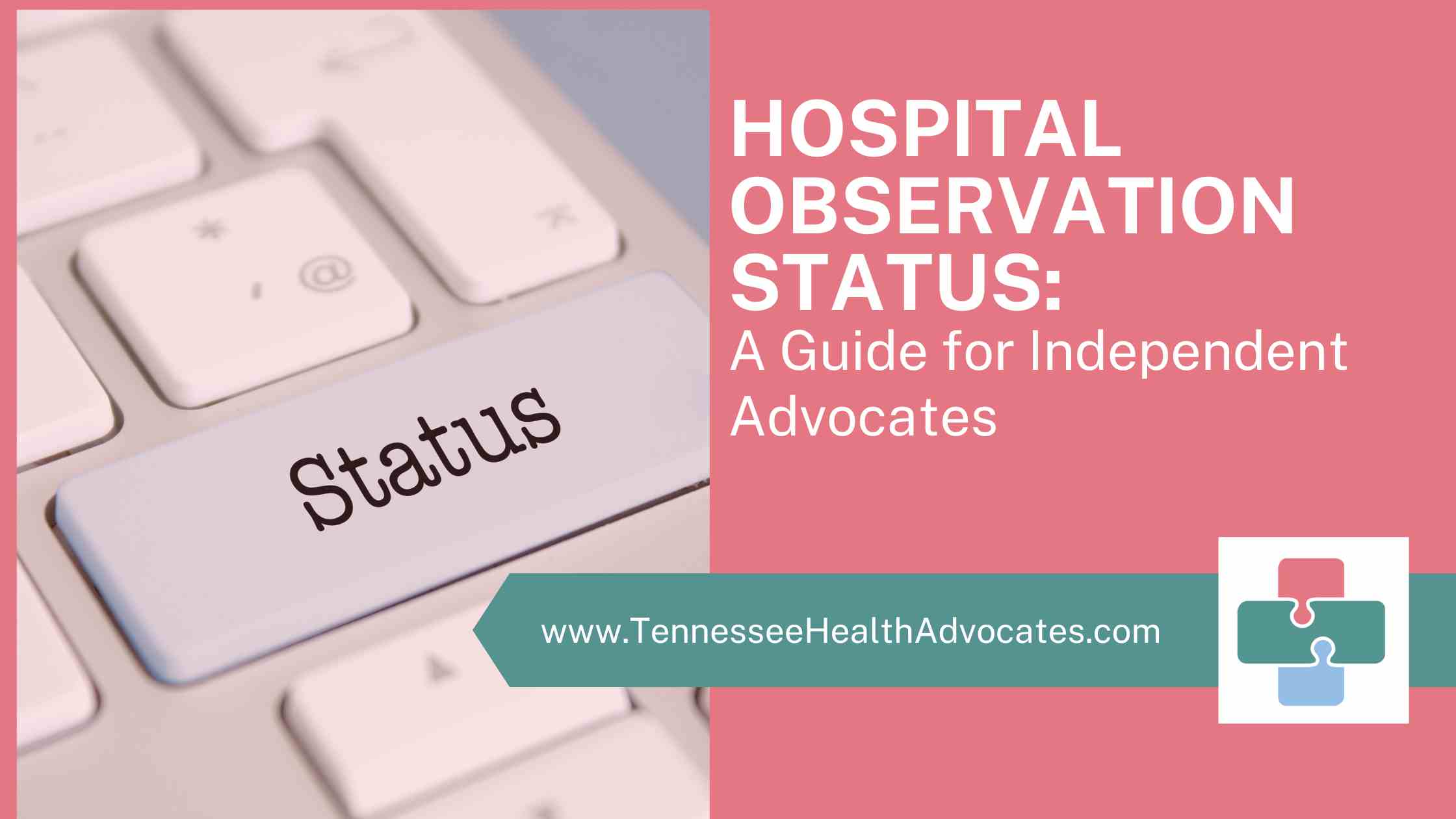Ever felt the maze of hospital observation status is a bit too puzzling? You’re not alone. In this blog, we’re decoding the intricacies to empower you. Imagine being the advocate who effortlessly navigates these complexities, ensuring the best for your clients. Curious? Stick around as we unravel the top three things you absolutely need to know. Your advocacy journey is about to get a whole lot smoother—let’s dive in!
Understanding Observation Status
What is Observation Status?
Observation status is a term that can cause much confusion. In simple terms, when a patient is placed under observation in a hospital, it means they’re receiving care, but they haven’t been formally admitted as an inpatient. This distinction is crucial because it impacts how services are billed and what expenses patients may incur. Unlike inpatient status, observation status is considered outpatient care, even if it involves an overnight stay.
Common Misconceptions:
Many patients might assume that time spent in the hospital is always as an inpatient. This misconception can have significant implications for coverage and costs. By understanding the nuances of observation status, you can proactively navigate the system, ensuring your clients receive the appropriate level of care.
Implications of Observation Status:
Being under observation might seem like a minor detail, but its implications are substantial. Patients in observation status may face limitations in coverage for certain services, particularly if they require post-hospital care. Early identification of observation status is key— it allows us to intervene promptly, ensuring our clients receive the necessary level of care and avoid potential financial setbacks.
In the next section, we’ll explore how as advocates we can play a proactive role in advocating for a timely transition to inpatient status. Read on for insights that will empower you to navigate observation status with confidence!
Advocating for Timely Transition to Inpatient Status
Proactive Advocacy:
In the world of patient advocacy, being proactive is the name of the game. As advocates, we can be instrumental in facilitating a timely transition from observation to inpatient status. Here are some actionable steps you can take to assist your clients:
Early Identification and Communication:
- The moment you suspect that your client might be placed under observation, start the conversation with healthcare providers. Communicate the potential benefits of inpatient status, ensuring they are aware of the comprehensive care your client may need.
Utilize Hospital Protocols and Pathways:
- Familiarize yourself with the hospital’s protocols for transitioning patients to inpatient status. Work collaboratively with the healthcare team to navigate these pathways smoothly, emphasizing the medical necessity and improved patient outcomes associated with inpatient care.
Leverage Documentation and Medical Necessity:
- If faced with resistance, gather and present compelling documentation supporting the need for inpatient care. Engage in medical necessity conversations and appeals when necessary, advocating for your client’s well-being and the appropriateness of inpatient status.
Effective Communication Strategies:
Navigating the transition from observation to inpatient status requires adept communication. Here are some actionable tips you can take to improve your communication with the healthcare team:
Clear and Assertive Communication:
- Clearly articulate the reasons for advocating inpatient status. Be assertive in presenting the medical necessity and anticipated benefits for the patient’s recovery.
Establish Collaborative Relationships:
- Build positive relationships with healthcare providers. Collaborate rather than confront, emphasizing the shared goal of ensuring the best possible care for the patient.
Follow-Up and Persistence:
- Don’t underestimate the power of follow-up. Persistent advocacy, coupled with regular check-ins, reinforces the importance of the transition and keeps the process on the healthcare team’s radar.
Common Challenges:
Addressing challenges head-on is part of effective advocacy. Here are the top three common challenges advocates may face when navigating observation status:
Resistance from Healthcare Providers:
- Overcoming reluctance from healthcare providers requires a strategic approach. Educate them on the benefits of inpatient care and provide evidence supporting the transition.
Navigating Administrative Hurdles:
- Administrative processes can be labyrinthine. Develop a clear understanding of hospital protocols and administrative pathways to navigate potential hurdles effectively.
Managing Patient and Family Expectations:
- Communication isn’t only with healthcare providers; managing patient and family expectations is equally crucial. Transparently explain the transition process, potential challenges, and expected outcomes to foster understanding and cooperation.
Empowered with proactive strategies and effective communication tips, you can champion the timely transition to inpatient status, ensuring optimal care for your clients. In the next section, we tackle the intricacies of navigating billing and reimbursement challenges associated with observation status.
Navigating Billing and Reimbursement Challenges
Breakdown of Billing Challenges:
Understanding the financial intricacies of observation status is vital for us as we help our clients navigate the financial implications. Here are a few of the primary challenges patients are likely to face and things we need to be aware of as independent patient advocates. Here are some things to consider:
Insurance coverage/Benefits:
- Observation status often comes with its own set of billing complexities. Patients might find themselves subject to outpatient rules, impacting coverage and costs. It’s essential to grasp these intricacies to effectively advocate for your clients. Patients under observation may face unexpected costs, especially if they require post-hospital care. From rehabilitation services to prescription medications, advocates need to anticipate and address these potential pitfalls in the billing process. Benefits and coverage can be different and specific to your client’s health insurance policy and carrier. Be certain to review their policy documents and/or contact member relations to clarify benefits and coverage. You can find benefit and coverage information for Medicare Beneficiaries at CMS.gov
Medicare Requirements (MOON):
- For Medicare beneficiaries, understanding the Medicare Outpatient Observation Notice (MOON) is crucial. This notice outlines the patient’s status, the reason for observation, and the potential impact on coverage. Advocates should be well-versed in MOON requirements to ensure compliance and informed decision-making.
Strategies for Minimizing Costs:
Minimizing the costs for your clients in observation status is an important role as an independent patient advocate. Empower yourself and your client with these practical strategies to minimize out-of-pocket expenses:
Advocate for Inpatient Status:
- As discussed in the previous section, advocating for a timely transition to inpatient status can be a game-changer. Inpatient status often comes with more comprehensive coverage, reducing the financial burden on patients.
Explore Financial Assistance Programs:
- Investigate available financial assistance programs that can alleviate the burden of unexpected costs. Many hospitals offer assistance or charity care programs, and advocating for your client to access these resources can make a significant impact.
Review and Challenge Bills:
- Scrutinize medical bills meticulously. Identify any discrepancies or services that might be billed incorrectly due to observation status. Challenge these bills when necessary, ensuring your client is only responsible for legitimate expenses.
Navigating the Reimbursement Landscape:
Navigate the reimbursement landscape with these insights:
Stay Informed on Policy Changes:
- Healthcare policies are dynamic, and staying informed about changes in observation status rules and reimbursement policies is essential. This knowledge equips advocates to adapt their strategies accordingly.
Collaborate with Billing Departments:
- Establish a collaborative relationship with hospital billing departments. Understanding their procedures and timelines can facilitate smoother reimbursement processes and help resolve billing issues more efficiently.
Educate Clients on Coverage Options:
- Patient education is a powerful tool. Ensure your clients are aware of their insurance coverage, including the implications of observation status. Educated patients can make more informed decisions and actively participate in the billing and reimbursement process.
Armed with a comprehensive understanding of billing challenges and practical strategies, you can confidently champion the financial well-being of your clients.
Conclusion
In this exploration of hospital observation status, we’ve highlighted the complexities that often surface for patients. Now that you have a clear understanding of the implications, advocating for a transition, and navigating the financial implications, observation status, you are now ready to share the awareness. This awareness is the compass guiding you and your clients to success.
I believe advocacy thrives on shared experiences. I encourage you to share your triumphs, challenges, and insight. Your stories contribute to a collective wisdom that strengthens our advocacy community. For real-time support and in-depth discussions, consider joining us in The Circle. Our weekly LIVE calls provide a space to dive deeper into advocacy topics, exchange ideas, and stay abreast of the latest developments. Your active participation enriches not just your journey but the journeys of others in our community.
As we wrap up this blog, let’s carry forward the momentum, armed with knowledge and a commitment to continuous learning. Together, we can elevate patient advocacy to new heights.



[…] you’ve found these tips valuable, check out some of my other posts about Medicare and Observation Status. All of my posts are crafted to empower you on your healthcare advocacy journey. Explore and absorb […]